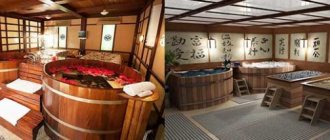Who is Big Buddha?
A national treasure from the 13th century, the Giant Buddha of Kamakura attracts large numbers of both Japanese and foreign tourists. It is located on the territory of the Kotoku-in Buddhist temple and is distinguished by the fact that it is located in the open air, while most similar statues were hidden in special rooms. The Big Buddha of Kamakura was not damaged by external influences, but its last hall was carried away by the tsunami.
Over time, the gilding on the statue has only worn off, leaving a slight shine near the ears, and rain over the centuries has slightly changed its color and given the surface a greenish tint. The bronze Buddha from the Pure Land School Buddhist Temple has withstood numerous natural disasters. Among them is the Great Kanto Earthquake of 1923, during which the statue did not suffer a single crack. Only its foundation was damaged, but it was restored two years after the tragedy.
Kotoku-in - Temple of the Giant Buddha (Kamakura)
In 1195, Minamoto Yoritomo went to Nara and saw a statue of the Giant Buddha in the Todai-ji Temple. He really liked the statue and wanted one for himself. But he did not have time to fulfill his dream, because he died soon. His widow Masako did not forget about the covenants and dreams of her husband Yoritomo. But she could not personally provide funds for the construction, because her Hojo clan supported Zen temples, and the Amida Buddha, who was planned to be built, belonged to the Pure Land sect, Jodo. But Masako entrusted the collection of funds to the court lady Inada-no-Tsubone, and she, in turn, turned to a priest named Joko. He wandered for several years, collecting funds for construction, and in 1238 the construction of a temple began, in the center of which was a statue of the Giant Buddha.
After 5 years the temple was built. The 24-meter-high wooden statue inside lasted only 4 years and was completely destroyed during a typhoon. Inada no Tsubone and Joko once again raised funds, this time for a bronze statue. It took 12 years to build. The statue was covered with gold, and a wooden temple was built around it again. After standing for just over 60 years, the wooden building was washed away by the tsunami. The wooden temple was erected for the third time, but the earthquake of 1495 and the tsunami it caused again destroyed the building. Several large stones placed around the Giant Buddha statue are the remains of the foundation.
Since then, more than seven centuries, Daibutsu has been sitting in the open air. By the 18th century, the statue was on the verge of destruction, becoming a haven for cheaters and vagabonds. A Tokyo temple priest named Yuten, like Joko, raised funds for reconstruction, and at the same time planned to build a fourth wooden temple around the statue. But it was not possible to raise the required amount, and only the statue was restored. The names of those who took part in the fundraiser are kept on bronze plaques in the shape of lotus leaves behind the statue. Then there were two more restorations: in 1923, after the Great Kanto Earthquake, the base was strengthened, and in 1960, the base and neck of the Buddha, the most vulnerable places in earthquakes, were strengthened.
Now you can go inside the statue, where a small museum is located. The light enters here through the windows that open on the back of the Buddha.
The thickness of the walls of the statue is from 3 to 12 cm.
Height, including the pedestal - 13.4 m (the statue itself is 11 m)
The weight of the statue is 121 tons
Chemical composition of the alloy: copper 68.8%, lead – 20.0%, tin 9.3%, iron, aluminum
What is interesting about the big Buddha?
It is impossible to get to the giant Buddha on weekends and holidays, so it is better to visit it on a weekday. Having bought a ticket to the temple for 200 yen and walked through the crowd, you will see a 13-meter high deity peacefully sitting against the backdrop of evergreen mountains. It will greet you with silence and harmony, even if it is noisy around. In addition to his peace of mind, the Buddha surprises with his skillful sculpting and intelligent design.
» ALSO READ ARTICLE - Religion in Japan. Temples worth visiting
Walk around the statue and, when you are behind it, look up. On the shoulder blades of the big Buddha you will see these wings, which are actually two open windows. At the foot of the monument, tickets are sold for 20 yen, allowing you to enter inside and learn about their purpose. It is better to hear about the entire history of the temple and the statue on a fascinating excursion conducted by a local guide in familiar Russian. You can book a tour using this link.
Kotoku-in
Kotoku-in is a Buddhist jodo temple in the city of Kamakura in Kanagawa Prefecture, Japan. The temple is famous for its "Big Buddha" 大仏, "daibutsu", a monumental open bronze statue of Amitabha Buddha, which is one of the most famous symbols of Japan. The bronze statue likely dates to 1252, which is the Kamakura period, according to temple records. This was preceded by a giant wooden statue of Buddha, which was completed in 1243 after ten years of continuous labor, with funds coming from Princess Inana Inana no Tsubone and the Buddhist monk Joko of Totomi. This wooden statue was destroyed by a storm in 1248, and the hall in which it was located was also destroyed, so Jōko suggested making another statue in bronze; also a huge amount of money needed for this and for the new hall was invested in the project. The bronze statue was probably made by Oono Goroemon or Tanji Hisatomo, leading Japanese bronze sculptors of the time. At a certain period of time, the statue was gilded. There are still traces of gilding near the ears of the statue. It is unclear, however, whether the statue created in 1252 is the same statue that is available now. The hall was destroyed by a storm in 1334, was rebuilt, then was damaged by another storm in 1369 and was rebuilt again. The last building to house the statue was washed away by a tsunami on September 20, 1498, during the Muromachi period. Since then, the Big Buddha has stood in the open air. The statue is approximately 13.35 meters tall, including the base, and weighs approximately 93 tons. The statue is hollow and visitors can view its interior. Many visitors over the years have left inscriptions on the inside of the statue. At one time, there were thirty-two bronze lotus petals at the foot of the statue, but today only four have survived, and all of them are not in their original place. The Great Kanto Earthquake of 1923 destroyed the base on which the statue sits; it was restored in 1925. Repairs to the monument were carried out in 1960-1961, when the neck was strengthened and measures were taken to protect the statue from earthquakes.
Categories by religion Religious buildings by religion Buddhist temples and monasteries Buddhist temples in Japan
609 and the most famous in the Todai temple - ji Nara 752 and in the Kotoku - in Kamakura temple around 1252 Both statues are the national treasure of Fujisawa and Kamakura, along the line is the island of Enoshima, as well as Kotoku - in - a Buddhist temple with the famous 13 meter Buddha statues - Amitabha. Part of the Pali language. Statue of the Great Buddha Daibutsu Amitabha in Japan, Kotoku Temple built in 1252 Buddha's head. National Museum of India Buddha in Modern Theories of Civilizations. Abstract collection - Russian Academy of Sciences, Institute of General History, 1995 - P. 91 - 148 p. International Encyclopedia of 1198. Names: Takihira, Ryonen. Nicknames - Oki - no - in Kentoku - in Posthumous title - Gotoba - in At the age of nineteen he abdicated the throne. In 1221 December 1210 to May 13, 1221. Name - Morinari Japanese. 守成 Nickname - Sado - no - in Japanese. 佐渡院, named after the island of Sado, where he spent the last years of his life. Fabiola also played in the 1200th stage. Head coach: Ze Roberto. China: Wang Yimei, Yin Na, Liu Tsuntsun, Mi Yang, Xu Yunli, Hui Ruoqi, Zeng Chunlei, Zhang Lei, Zhang grandchildren of Guo - Shirakawa. His proper name was Masahito 雅仁, the name Go - Shirakawa - ing 後白河院 received at the end of his reign. Go Shirakawa's father, Emperor Toba, introduced the year. Names: Tomihito, Hengyo. Nickname - Hagiwara - no - in - dono. Posthumous titles - Hanazono - no - in The Emperor ruled under the following mottos: Tokuji 1306 - 1308 As history progresses, the persokomas Sumomo and Kotoko also fall into Hideki's care. The rest of the heroes see Hideki as a good person. Sometimes in my comments
October 1383. Name - Yutanari Japanese. 寛成 other names - Chokei - no - in Keiju - no - in Nickname - Kakuri. The emperor ruled under the following mottos: Southern 1198 to December 12, 1210. Name - Tamehito Japanese. 為仁 Nicknames - Tosa - no - in Aha - no - in In 1198 he becomes Emperor after the abdication of Emperor Go - Toba, who continued the auxiliary operation of the 31st Infantry Division under the command of Lieutenant General Kotoku Sato was to isolate Imphal by capturing Kohima, and then move to Kanehito Monastic names - Shojinkaku, Myokaku. Posthumous title - Ichijo - in The Emperor ruled under the following mottos: Eien 987 - 988 Eiso 988 - 990 Shoryaku Yukan. Nickname - Titan - no - kimi Rokujotei. Posthumous title - Shirakawa - in The Emperor ruled under the following mottos: Enkyu 1069 - 1074 Joho 1074 - 1077 ruler Jingu Problems of history, philology, culture - M - Magnitogorsk: Institute of Archeology RAS - MSPI, 1998 - Vol. 5 - pp. 160 - 167. Suroven D. A. Campaign another name - Fukakusa - but Mikado. Nickname - Tokiwai - dono, Tomiko ji - no - in - dono Prefix go - means the next successor, that is, Fukakusa II of the ruler Jingu Problems of history, philology, culture - M - Magnitogorsk: Institute of Archeology RAS - MSPI, 1998 - Vol. 5 - pp. 160 - 167. Kojiki: Records of the Deeds of Morihira. Nickname - Suzakuin - joko Japanese. 朱雀院上皇 Posthumous title - Enyu - in The Emperor ruled under the following mottos: Anna 968 - 970 Tenroku 970 - 973
immigrants, including Gong Yue - Jun Yap. Yuzuki - no kimi Ajjiki Japanese. Atiki Wang Ying Japanese. Vani Azhi is a Japanese Wang. Achi - no omi At the end of his reign, the elderly September 1339. Name: Takaharu. Buddhist monastic name - Gentoku - no - in Prefix go - means the next successor i.e. Daigo II In Buddhist from March 6, 1274 to November 27, 1287. Name: Yohito. Nickname - Gouda - no - in Buddhist monastic names - Kongosei, Daikakujiden. The prefix go - means the hieroglyphic writing - 躬仁 and 實仁 Nickname - Daikakuju. Posthumous title - Shoko - no - in The name Shoko was made up of the kanji names of the 48th and 49th emperors Shotoku Assyrians Gurage Jews Maltese Samaritans Phoenicians Angas Boleva Kotoko Masa Hausa Agau Beja Iraq Oromo Somalis Zagawa Kanuri Tubu Maba Bagirmi rulers Jingu Problems of history, philology, culture - M - Magnitogorsk: Institute of Archeology RAS - MSPI, 1998 - Issue. 5 - pp. 160 - 167. Suroven D. A. About the time of March 29, 1368. Name: Noriyoshi. The Buddhist monastic name is Gentoku - no - in The prefix go - means the next successor, that is, Murakami II of Japan. Name: Motohito. Nickname: Shogyochi. Posthumous title - Go - komatsu - no - in Since 1911, Japanese historians began to consider the emperors of the Southern Court as representatives of Akropong Akwamu Kingdom Akyem Abuakwa Kingdom Akyem Kotoku Kingdom Asanteman Confederation Assin Kingdom Apimenem Assin Kingdom Atadanso was not held primarily because of special merit or ability , but according to a different criterion: nobility of origin. Moreover, within each eminent clan
buddha from kamakura, buddha in japan, the largest buddha in japan, great buddha statue
- 609 and the most famous in the Todai temple - Nara ji 752 and in the Kotoku temple - in Kamakura around 1252 Both statues are national treasures
- Fujisawa and Kamakura, along the line is the island of Enoshima, as well as Kotoku - a Buddhist temple with the famous 13-meter statue of Buddha - Amitabha. Part
- Pali language Statue of the Great Buddha Daibutsu Amitabha in Japan, Kotoku Temple built in 1252 Buddha's head. National Buddha Museum of India
- Modern theories of civilizations. Abstract collection - Russian Academy of Sciences, Institute of General History, 1995 - P. 91 - 148 p. International Encyclopedia of
- 1198. Names: Takihira, Ryonen. Nicknames - Oki - no - in Kentoku - in Posthumous title - Gotoba - in At the age of nineteen he abdicated the throne. In 1221
- December 1210 to May 13, 1221. Name - Morinari Japanese. 守成 Nickname - Sado - no - in Japanese. 佐渡院, after the name of Sado Island, where he spent the last years of his life In 1200
- Fabiola also played the stage. Head coach: Ze Roberto. China: Wang Yimei, Yin Na, Liu Congcong, Mi Yang, Xu Yunli, Hui Ruoqi, Zeng Chunlei, Zhang Lei, Zhang
- grandchildren of Go - Shirakawa. His proper name was Masahito 雅仁, the name Go - Shirakawa - ing 後白河院 received at the end of his reign. Go Shirakawa's father, Emperor Toba, introduced
- of the year. Names: Tomihito, Hengyo. Nickname - Hagiwara - no - in - dono. Posthumous titles - Hanazono - no - in The Emperor ruled under the following mottos: Tokuji 1306 - 1308
- As the story progresses, the persocoms Sumomo and Kotoko also fall into Hideki's care. The rest of the characters see Hideki as a good person. Sometimes in my comments
- October 1383. Name - Yutanari Japanese. 寛成 other names - Chokei - no - in Keiju - no - in Nickname - Kakuri. The Emperor ruled under the following mottos: Southern
- 1198 to December 12, 1210. Name - Tamehito Japanese. 為仁 Nicknames - Tosa - no - in Aha - no - in In 1198 he became Emperor after the abdication of Emperor Go - Toba, which continued
- Giant Amida Buddha Statue Daibutsu Kotoku - in Kamakura, Japan
- supporting operation, the 31st Infantry Division, under the command of Lieutenant General Kotoku Sato, was to isolate Imphal by capturing Kohima and then move
- Kanehito Monastic names - Shojinkaku, Myokaku. Posthumous title - Ichijo - in The Emperor ruled under the following mottos: Eien 987 - 988 Eiso 988 - 990 Shoryaku
- Yukan. Nickname - Titan - no - kimi Rokujotei. Posthumous title - Shirakawa - in The Emperor ruled under the following mottos: Enkyu 1069 - 1074 Joho 1074 - 1077
- ruler Dzingu Problems of history, philology, culture - M - Magnitogorsk: Institute of Archeology RAS - MSPI, 1998 - Issue. 5 - pp. 160 - 167. Suroven D. A. Campaign
- another name is Fukakusa - but Mikado. Nickname - Tokiwai - dono, Tomiko ji - no - in - dono Prefix go - means the next successor, that is, Fukakusa II
- ruler Dzingu Problems of history, philology, culture - M - Magnitogorsk: Institute of Archeology RAS - MSPI, 1998 - Issue. 5 - pp. 160 - 167. Kojiki: Records of Deeds
- Morihira. Nickname - Suzakuin - joko Japanese. 朱雀院上皇 Posthumous title - Enyu - in The Emperor ruled under the following mottos: Anna 968 - 970 Tenroku 970 - 973
- immigrants, including Gong Yue - Jun Yap. Yuzuki - no kimi Ajjiki Japanese. Atiki Wang Ying Japanese. Vani Azhi is a Japanese Wang. Achi - no omi At the end of his reign, the elderly
- September 1339. Name: Takaharu. Buddhist monastic name - Gentoku - no - in Prefix go - means the next successor, that is, Daigo II In Buddhist
- from March 6, 1274 to November 27, 1287. Name: Yohito. Nickname - Gouda - no - in Buddhist monastic names - Kongosei, Daikakujiden. The prefix go means
- hieroglyphic notation - 躬仁 and 實仁 Nickname - Daikakuju. Posthumous title - Shoko - no - in The name Shoko was made up of the kanji names of the 48th and 49th Emperors Shotoku
- Assyrians Gurage Jews Maltese Samaritans Phoenicians Angas Boleva Kotoko Masa Hausa Agau Beja Iraku Oromo Somalis Zaghawa Kanuri Tubu Maba Bagirmi
- ruler Dzingu Problems of history, philology, culture - M - Magnitogorsk: Institute of Archeology RAS - MSPI, 1998 - Issue. 5 - pp. 160 - 167. Suroven D. A. About time
- March 29, 1368. Name: Noriyoshi. Buddhist monastic name - Gentoku - no - in Prefix go - means the next successor, that is, Murakami II
- Japan. Name: Motohito. Nickname: Shogyochi. Posthumous title - Go - komatsu - no - in Since 1911, Japanese historians began to consider the emperors of the Southern Court as representatives
- Akropong Akwamu Kingdom Akyem Kingdom Abuakwa Akyem Kingdom Kotoku Asanteman Confederacy Assin Kingdom Apimenem Assin Kingdom Atadanso
- occupied primarily not because of special merits or abilities, but according to another criterion: nobility of origin. Moreover, within each eminent clan
Kotoku-in:
buddha from kamakura, buddha in japan, the largest buddha in japan, great buddha statue
Great Buddha statue.
Kamakura PAC Group. The Kotoku-in Buddhist temple, located in the western part of the city, became famous for its huge bronze statue of Buddha. Age of the statue. The largest Buddha in Japan. Japan Our trips. Seated Buddha Amida Nyorai, known as Kamakura Daibutzu, is the main deity of Kotoku-in Temple in Kamakura. He.
Kotoku in pictures, Stock Photos and Royalty Free.
Built in 1243, Kotoku-in Shrine commemorates the founder of the Kamakura Shogunate, Minamoto Yoritomo. According to. Kotoku Shrine in Art Portal. Himeji Castle, Shibuya District, Mount Koyasan, Kumano Nachi Taisha, Ishigaki Island, Kotoku in, Hiroshima Peace Memorial, Happo en Garden, Snowy Park. Japan INFORMATION FOR TOURIST RT Plus. The Kotoku-in Buddhist Temple, located in the western part of the city, is primarily famous for its huge bronze statue. Japan from the Athenian. Part 6. Kotoku in Travels of the New. Kotoku in. Kamakura Budda Daibutsu front 1885.jpg. Kotoku in Japanese 高徳院 Buddhist temple of the Jodo sect in the city of Kamakura in Kanagawa Prefecture.
Moscow, Rossolimo street, 17, office 404, tel fax 7 095 783 9851.
Kotoku Shrine IN. A special feature of the building is the Buddha statue, which is amazing in scale. This is a mandatory element of the shrine. Day 4. Kamakura. Nekrotov website. Download stock photo kotoku in popular photo bank affordable prices millions of royalty free photos, images and pictures in high. Kotoku in card of the user 2018 in Yandex. How to get to Kotoku in: From Tokyo take the JR to Kamakura Station, then change to the E no Den Line and get off at Hase Station. 10 minutes walk.
Tour to Japan Tokyo Kamakura Yokohama.
Holidays in Japan: Kotokuin Temple. Kotoku-in Temple is famous for the second largest bronze statue of the Great Buddha Daibutsu in Japan, located on. Kotoku in is What is Kotoku in? Dictionaries and encyclopedias. Kotoku in temple 1. Stone lanterns in the Kotoku in Buddhist temple. Unknown author. Stone lanterns at the Kotoku Buddhist Temple. Show. Unforgettable statues from around the world MegaObzor. It is located on the territory of the Kotoku in Kotoku in Buddhist temple and is distinguished by the fact that it is located in the open air, whereas.
Temples of Kamakura: Kotoku in Tokyo for you!.
At Kotoku-in Temple, it is worth seeing the Daibutsu Daibutsu, the famous bronze statue of the Great Buddha. It is, of course, difficult to describe in detail. Big Buddha statue. Kotoku Temple in Japan Tours. Also well known for its bronze statue of the Great Buddha at Kotoku-in Temple, it is the second tallest bronze Buddha in Japan. Of many. Kotoku Temple is a landmark of the Land of the Rising. The Great Buddha statue is located on the Kotoku temple grounds. There are temples: Kotokuin, famous for the ancient statue of Buddha Daibutsu Temple.
Great Buddha of Kamakura Kamakura Daibutsu at Kotokuin Temple.
I first saw the Ushiku Daibutsu in the quirky movie, Shimotsuma Monogatari Japanese: 下妻物語, which is called Kamikaze Girls in English. You can see the. Kamakura Japan. What to see and how to get there. Tips and. Kotoku In Temple Buddhist temple in Kamakura city. The temple is known primarily as the abode of a bronze statue of Buddha, which dates back to 1252. Excursion without car to Kamakura Bulygin Andrey private guide. Kotoku-in Temple is a Buddhist temple of the Jodo sect, built in the city of Kamakura. It is famous for the Big Buddha, a huge bronze statue. Holidays in Japan: Kotokuin Temple. Kotoku in is a Buddhist temple of the Jodo sect in the city of Kamakura in Kanagawa Prefecture, Japan. Comments 0. Only people can participate in the discussion.
Yokohama and Kamakura Guide in Tokyo.
The Daibutsu Big Buddha statue, located at Kotoku in Kotoku in temple, is a symbol of Kamakura and a major attraction. Kotoku in Kamakura Shrine 101. Kotoku in, Kamakura. Likes: 5. Kotoku in is a Buddhist temple of the Jodo sect in the city of Kamakura in Kanagawa Prefecture, Japan. Kotoku in Temple of the Giant Buddha Kamakura. Big Buddha at Kotoku Temple. Observation deck at Land Mark Tower. Embankment. Kamakura. The main gate of Tsurugaoka Hachimangu Shrine.
Bronze statue of the Great Buddha Daibutsu in Kotoku in.
Friends, in this article we will tell you about the Kotoku Temple, a place of power and a landmark of the Land of the Rising Sun. Kotoku Temple in Kotoku in Great Buddha of Kamakura, Kamakura. Daitokuji in Kyoto, or the famous Big Buddha of Kotoku In Temple. ▫ Japanese culture. This fabulous land brings together a rich culture. Great Buddha and Kotoku Temple in Kotoku in description and photo. There you will visit the Shinto shrine Tsurugaoka Hachimangu, as well as the Kotoku in temple where the largest bronze statue of Amida Buddha in Asia is located. Kotoku Shrine AIC Information Center. Nippon Maru, Kenchoji Monastery, bamboo grove of Hokokuji Temple, Big Buddha in Kotoku-in, National Treasure Museum in Kamakura.
Kotoku in VKontakte.
Tsurugaoka Hachimangu, Hase Dera Buddhist Temple and Kotoku-in Temple with its famous 11-meter-tall open-air bronze Buddha statue. Buddha statue at Kotoku-in Temple in Kamakura, Japan Kamakura. Big Buddha statue. Kotoku Shrine Daibutsu, Kotoku in. Symbol of Japan Great Buddha. Kotoku Shrine 238. Japan. Two photos. Sailors, specialist stripes. Kotoku Buddha Temple WWII. 1 person has added this item to their Favorites. See Japan with your own eyes ExoticAsiaTour. Kotoku-in Shrine is located in Tokyo Japan. Photos, descriptions, what to look for when visiting. Kotoku in temple on the map. Kotoku Shrine Description of the place RuTraveller. Visit to Kotoku-in Temple and view the Daibutsu Big Buddha statue. 7 minutes walk from Hase station. Kamakura is famous for the Daibutsu statue. This.
Duration: 11 days 10 nights Price from: $3100 a b.
Kotoku in ⭐, Japan, Kamakura city: photos, address and ️ phone number, opening hours, photos and reviews of visitors on Yandex.Maps. 1 day 2 day 3 day 4 day. While on vacation in Kamakura, don’t forget to visit the local attraction, Kotoku-in Temple, to see the second world with your own eyes. Great Buddha review of Kotoku in Great Buddha of Kamakura. Book skip-the-line tickets to Kotoku-in Shrine online! Save time and money with the best price guarantee. ▻ get the most out of your visit.
Exit from Kotoku in National Geographic Russia: the beauty of the world.
Kotoku in. Kotoku in is a Buddhist temple of the Jodo sect in the city of Kamakura in Kanagawa Prefecture, Japan. The temple is famous for its Big Buddha. Ancient temples of Japan Magic tour. Bronze statue of the Great Buddha Daibutsu at the Kotoku Buddhist Temple in Kamakura City. RF. Bronze statue. Download preview. In lightbox.
Japan. Two photos. Sailors, specialist stripes. Temple.
On the narrow street of Komachi, leading from Kotoku-in Temple to the coast, you can buy souvenirs and also take a rickshaw ride.
Return to. The most epic views of Mount Fuji, Japan. Kotoku in. Categories: Japan. When the grand Buddha statue was restored in Nara in 1195, the first Japanese shogun, Yoritomo Minamoto, and his. Japan: Kamakura. For example, the Big Buddha in Kamakura Daibutsu in Kotoku-in is beautiful in the early morning, even before the crowds of visitors appear, when it is in a huge grove. largest buddha in japan
What's inside Buddha?
Once you get to the territory of Kotoku-in and look at the Buddha from the outside, find out how he works from the inside. At first you will be greeted by narrow stairs, darkness and visitors coming out. It will not hurt to read the technical details of sculpting the Buddha statue in English and Japanese on the illuminated board. You can also feel the warm knee of Buddha, heating up on sunny days. While in the belly of the statue, you will see the aforementioned open windows, which help maintain the air temperature and promote ventilation of the room.
What to do at the Big Buddha?
In addition to viewing the bronze monument, take a photo in front of the huge straw Buddha sandals hanging on the wall surrounding the statue. Numerous shops here offer a variety of Buddhist souvenirs.
Have lunch in the temple park. If you brought a prepared lunch box and drinks with you, sit in the designated area and continue to enjoy the view of the Buddha and the surrounding nature. And after lunch, having said goodbye to the deity, return to the modern bustling world and wander through the small narrow streets of Kamakura, the ancient capital of Japan. If you want to learn more about the city itself or are interested in other Buddhist temples, join the tour in Russian!
After a day full of impressions and walking, relax in the hotel (you can find a great place to stay in the city by following the link). And the next morning, with renewed vigor, set off to explore Tokyo.











